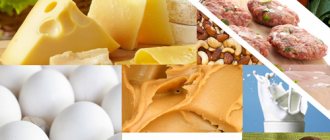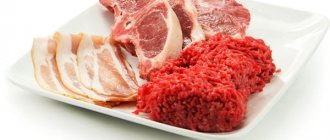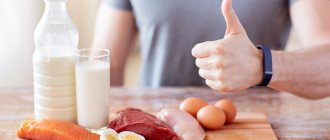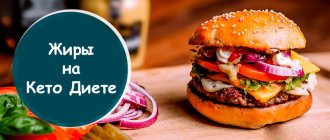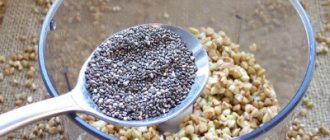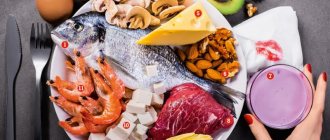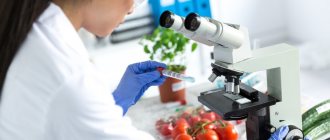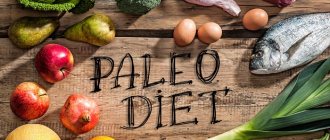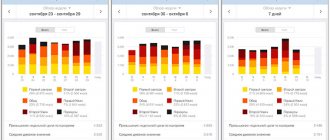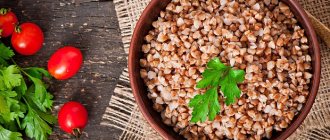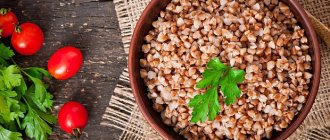Hello friends! Do you know how to stop craving sweets, start eating fatty foods and, finally, lose weight with virtually no food restrictions and no exercise? Read on, and I will tell you how a keto diet (menu for a week) for women will help you lose weight and discourage the desire to devour candy and cookies. Yes it is possible!
My blog is a place where I constantly tell you secrets for losing weight. You've hopefully noticed that I adhere to three basic principles: don't hurt yourself, don't lose the pleasure of eating well, and don't torture yourself too much.
Today's post will also be no exception. I will talk about a nutritional system that contains in its diet a large number of permitted foods, and most importantly tasty ones. The results will also not keep you waiting.
However, I always start each of my posts about diet with a warning - be sure to consult your doctor before starting. Because keto nutrition has serious contraindications and is not suitable for all people. But more on that below.
What is keto nutrition?
If you are already familiar with this term, then you can safely move on to the point about what you can eat. I also collected recipes for every day.
If you haven’t heard about this nutrition yet, I advise you to stay here and read. It will be useful.
Did you know that you can and should eat fat to lose weight? Almost all doctors in the world are now writing about this. Butter, lard, and pork are no longer on the stop list for many stars and athletes. How is this possible?
The name of the diet in English is Ketogenic, which means “rich in fat” in English. If fried potatoes come to mind, you're wrong.
Mark Gieman, a famous American nutritionist, gives an example:
“How is foie gras (goose liver filled with fat) prepared? The goose is forcibly and for a long time fattened... is it really fat? No, carbohydrates! It’s not fat that causes fatty liver disease, it’s sugar.”
We are not talking about fried food, but about enriched with healthy fats. There are many of these in fish, oil, nuts, and some vegetables. These elements are extremely important for the body, especially useful for nursing mothers. Omega 3 and other microelements help restore hormonal balance, affect the regular cycle, and are also necessary for the child in the first two years of life for further normal brain development. If you want to raise a person with a flexible and inquisitive mind, do not forget to eat the foods listed below while breastfeeding, and also be sure to introduce them into your baby's diet.
Strictly speaking, the Ketogenic diet can hardly be called a diet. Rather, it is a daily nutrition system with a rich diet and a specific list of products. It takes into account the daily weight of proteins, fats and carbohydrates. This way you get all the necessary elements, eat well and lose weight.
Eat natural food!
Focus on minimally processed, good quality natural foods! Ideally, the products you buy should not even contain a list of ingredients, or the list should be short.
Industrially unprocessed natural food is what our ancestors have eaten for millions of years, and what the human body has evolved to adapt to. Processed foods, such as refined carbohydrates, increase the rate of absorption and reduce the amount of nutrients in the food. Thus, we get food that is unnatural for our body. And thus, there is a risk of side effects for health.
How it works?
We used to think, or rather, we were so often told, that glucose is needed to start metabolism. Where can I get it? Of course, in foods with a lot of carbohydrates - cereals, whole flour, fruits.
Try a more gentle diet, but similar in principle to keto - low carb high fat or lchf diet (high fat low carbohydrate).
However, in this case, the body burns these quick and long-lasting carbohydrates without touching the existing fat at all. It is, as it were, put aside for a “rainy day” and is an emergency reserve, which greatly upsets us.
Receive a book as a gift >
The Ketogenic diet is based on a lack of carbohydrates. As soon as the body realizes that there is not enough fast fuel, it takes on the resources that are already available, that is, our deposits on the sides and hips.
Ketosis sets in - the body takes energy from fats. Sounds like a dream.
Contraindications
Despite the benefits, the keto diet has contraindications:
- pregnancy, breastfeeding period;
- high cholesterol;
- diabetes;
- diseases of the gastrointestinal tract, heart, kidneys;
- difficulty digesting fatty foods;
- malfunction of the thyroid gland;
- porphyria.
Ketosis - what is it?
Ketosis is a condition that develops as a result of carbohydrate starvation of cells, when the body begins to break down fat to obtain energy with the formation of a large number of ketone bodies (quote from Wikipedia).
In simple words, energy comes from fats, and not from carbohydrates, as our body is used to.
How to achieve ketosis
- Maintain the balance of BZHU at level B - 20%, F - 75%, U - 5%;
- Glycogen reserves are consumed within 2-3 days;
- The keto flu comes (lethargy, dizziness, etc.), on average it lasts from 2 to 10 days. The more carbohydrates you ate before the keto diet, the more severe the keto flu will be.
- Ketosis sets in.
Signs of ketosis
- Energy boost
- Clear thoughts
- Decreased appetite
The disadvantages of ketosis include:
- Thirst at night
- Need to watch potassium, magnesium and sodium (supplementation)
- The bad breath may bother you at first
You don't have to be in ketosis to lose weight, you'll just lose weight more slowly.
This is why the ketogenic diet is effective not only for losing weight, but also for maintaining the result.
The essence of the diet
You will be surprised, but the keto diet was developed at the beginning of the 20th century - it was used to treat epileptic seizures in children. Doctors discovered an interesting side effect - weight loss in patients and a decrease in body fat. After this, the keto diet began to be successfully used in dietetics. (more details about the research and results in the Wikipedia article)
Before you try a new way of eating, you need to understand the basic truth of nutritionists: the desired effect is directly proportional to the effort made.
The cyclical keto diet will only help you if you want it to.
The keto diet or ketogenic diet is a low-carbohydrate, high-fat diet. Protein is also present in the diet, but in moderation.
For the brain to function, humans need glucose. The main source of “fuel for the brain” is carbohydrates. Since the keto diet inherently involves almost complete absence of them, the question arises: what will our brain be fed?
Let's figure it out. With a reduced carbohydrate content in the diet, the liver begins to produce fatty acids and glycerol. These breakdown products form ketone bodies. They do an excellent job of feeding the brain and maintaining its performance. A low amount of carbohydrates forces our body to urgently rebuild itself, using glycogen reserves in the muscles and liver. The process of glycolysis stops completely and lipolysis begins - the breakdown of fats.
© NinaMunha — depositphotos.com. Keto diet food pyramid
Types of diet
There are several types of diet:
- Standard is the most common keto diet. The main idea is to almost completely avoid carbohydrates.
- The goal is to consume a small amount of carbohydrates after training to replenish glycogen and increase the effectiveness of the training process.
- Cyclic – introducing carbohydrates into the diet as needed. As a rule, this is done intuitively as the body becomes exhausted.
Stages of body adaptation
Preparation for lipolysis and adaptation of the body to the ketogenic diet occurs within a week. It all depends on the individual characteristics of metabolism. At the first stage, glycogen is produced, obtained from food in which carbohydrates were present. The next stage is the use of glycogen reserves in muscle tissue and liver.
The duration of these two stages is approximately 1-2 days. The body then tries to obtain energy from the proteins present in the diet. The muscles of the body are also used. This stage is the most difficult both psychologically and physically. It lasts 3-5 days. The logical result: the body’s adaptation to an extreme regime, the production of ketone bodies and the burning of adipose tissue. Protein breakdown in turn slows down. If all recommendations are followed, depending on the characteristics of the body, excess weight loss ranges from 0.5 to 2.5 kilograms per week.
What is possible and what is not?
In order to lose weight, you don't have to deprive yourself of food. It is necessary to correctly calculate the dose of BJU. And I'll tell you how.
The amount of enriched fats received per day is 80%, proteins - 15%, carbohydrates - 5%.
If necessary, coals can be increased to 10%, then the ratio will be 30B/60Zh/10U.
Formula for calculating BZHU and calorie content
For example, let’s take a 30-year-old woman, weighing 70 kilograms and height 165 cm.
We calculate the value of Basal Metabolic Metabolism (BMR) using the Mifflin-San JEORA formula:
BOO=9.99*weight(kg) + 6.25*height(cm) - 4.92*age - 161
Next, we multiply BOO by KA (activity coefficient). If you want to lose weight, make a calorie deficit of 20%. If you lead a sedentary lifestyle, your CA will be equal to 1.2.
RSK = BOO * 1.2 - 20% = your recommended daily caloric intake.
Next, we need to calculate the rate of BZHU.
As you know, the keto proportion of BJU is 15/80/5, we consider:
- B = RSC * 0.15 : 4 = your protein requirement in grams
- F = RSK * 0.8 : 9 = your fat requirement in grams
- U= RSK*0.05: 4= your carbohydrate norm in grams per day
SBI = 9.99*70 + 6.25*165 - 4.92*30 - 161 = 699.3+1,031.25+147.6-161 = 1,717.15
RSC = 2,060.58 - 412.116 = 1,648.464
B = RSC*0.15: 4 = 1,648.464*0.15: 4 = 61.8174
F= RSC*0.8: 9 = 1,648.464*0.8: 9 = 146.53
U= RSC*0.05: 4 = 1,648.464*0.05: 4 = 20.6058
Yes, it’s difficult to count! But it is possible. For the first month, it is recommended not to adhere to strict calorie counting while the body gets used to new foods, and learn to manage with a minimum of carbohydrates!
The right amount of fat
Fats are easy to calculate. Having determined the norm of proteins and carbohydrates, get the rest of your calories from fat-containing foods. If you want to gain a little weight, increase the indicator by about 500 Kcal or 55 g. To lose weight, reduce it by 200-500 Kcal or 22-55 g.
At the start of the keto diet, many people are faced with a subconscious fear of fats. I remember those days very well: “It was extremely difficult. All our lives we have been taught that fats cause obesity, heart attacks and strokes. And then suddenly you need to eat 200 g of fat every day. To achieve results, you will have to overcome a serious psychological barrier. It’s like going back to the Middle Ages and proving to people that the earth is round.”
And yet, in the first couple of days it will be difficult to eat enough fat. Replenish the deficiency with butter, nuts, olive and coconut oil and fatty meats. But be careful with polyunsaturated fats found in soybean, corn and sunflower oil. Those who abuse them often develop digestive disorders and are forced to abandon the ketogenic diet.
What products are allowed?
The list of ingredients is quite long:
- fish (there are no exceptions here, eat any),
- seafood,
- meat (including pork and poultry with skin),
- vegetable oils (with a limitation - sunflower and flaxseed), preference should be given to coconut, olive, avocado, ghee (melted), mst,
- animal oils (butter, duck, goose fat),
- avocado,
- fermented milk products (this is exactly the case when 0% fat content is not worth buying, feel free to take 30%),
- vegetables, greens (but only those that grow above the ground - potatoes, beets, turnips, carrots are not suitable, but a little can be added to dishes),
- nuts, sour berries, strawberries, raspberries, blueberries in small quantities,
- mushrooms,
- dry wine, low-carbohydrate alcohol - brandy and cognac,
- You can even have mayonnaise, but only homemade (without starch and sugar).
But here’s what you should give up, and then the results will not keep you waiting:
- sweets and flour products,
- sweet fruits,
- beer, semi-sweet wine, champagne,
- fast food,
- cow's milk,
- legumes,
- cereals.
What is there, you ask? And I just have a menu for you. But before that, let's look at the pros and cons of eating high-fat foods.
For special occasions
You decide for yourself whether you should consume the following products or not. By consuming the following foods, your weight loss may slow down slightly.
Alcohol: preferably dry wine (dry red or white wine), champagne, whiskey, brandy, vodka and sugar-free cocktails. Read our separate extensive article: What kind of alcohol can you eat on a keto diet?
Dark chocolate : A small piece of dark chocolate with a cocoa content higher than 70% will definitely not hurt you. Try making a dish with a small portion of 85% chocolate grated on top of the berries with whipped cream. Read our separate extensive article: Keto snacks and snacks: what is possible?
Pros and cons of the keto diet
This point is a must-read for anyone who wants to try this option for losing weight and volume.
Let's start with the pleasant things.
Undoubted advantages
- reduction of centimeters without a constant feeling of hunger. You always feel full and your diet includes a varied menu,
- I don't really want sweets. When you eat a full meal, the desire to snatch a cookie or candy does not arise. By the way, cashews or almonds perfectly satisfy the passion for fast carbohydrates,
- Lots of room for creativity in the kitchen. The keto diet has a number of restrictions, but leaves a lot of menu options,
- weight and volumes go away forever and do not return (albeit, provided that the system is maintained),
- it is not necessary to exhaust yourself with sports, it is more important to monitor the amount of calories and nutritional supplements,
- suitable for ongoing compliance (with some restrictions),
- you get almost all the necessary microelements for health,
- There are no restrictions on meal times.
Disadvantages of the diet
And we will dwell on them in detail.
- There are a number of contraindications. Total consumption of fatty foods is prohibited for pregnant and lactating women who are allergic to the described ingredients. For people with diabetes, liver diseases, and gastrointestinal tract diseases, it is worth consulting with your doctor.
- The diet has a number of temporary consequences. For some they go unnoticed, for others they are pronounced.
- Ketoflu may occur . The symptoms are similar to a cold: the temperature rises for a short time, chills and weakness occur. Typically, ketosis flu appears in the first couple of weeks. Then it goes away on its own without treatment. It is important at this moment not to get too cold and drink a lot of mineral water.
- Also an unpleasant temporary consequence is the smell of acetone from the mouth or skin. This happens when the body adapts to a new system of work. Drinking plenty of fluids helps ease temporary difficulties. When the body readjusts itself, the smell will disappear.
- If you decide to eat fatty foods, it will last for a long time. Cravings for sweets are unacceptable (but, as I said above, you most likely won’t even want to). Otherwise, you will recover quickly and will not start the metabolic mechanism. The body will understand that if light fuel has already arrived once, it means it will come again. He will wait and be reluctant to waste subcutaneous reserves.
- The price of such a diet. Let's face it, eating the foods on the list can be expensive. The cost of avocados in different stores can be from 70 to 250 rubles per piece, or even higher. Nuts are also not a cheap pleasure.
Of course, meat, fermented milk and eggs are regular guests on many people’s tables, but for variety we also need mushrooms and fish. Keep in mind, the price of your grocery basket may increase.
Remember, the pounds don't go away instantly. On average, during the first 2 weeks, water is drained (2-3 kg), and then the process progresses more slowly. It takes weeks for the volumes to start going away. But further results will be pleasing. Read the reviews of those who switched to such a power system. Be patient.
Be attentive to the listed contraindications and do not harm yourself!
Advantages
When maintaining a keto diet:
- the number of acne is reduced due to the stabilization of insulin (low blood sugar);
- the risk of HDL, heart disease and increased blood pressure on a ketogenic diet is reduced to zero;
- support in the treatment of cancer, tumor growth slows down;
- reducing symptoms of Alzheimer's disease;
- reduction of seizures in epilepsy in children and adults up to 50%;
- reduces the manifestation of Parkinson's symptoms.
Electrolytes on keto
It is necessary to take additional Mg, Ca and K if you are not getting enough of them from foods. Plus, be sure to salt all food, or add the trace element Na to the list. Calcium is usually not a problem on Keto, but many people are deficient in magnesium and potassium.
Sources of magnesium, percentage of daily requirement indicated
Daily value for women:
- magnesium - 310-320 mg (depending on age),
- potassium - 2.5 g,
The balance of potassium and sodium (K:Na) in the diet should be at least 2:1. That is, you need to eat more potassium. Read about the sodium-potassium pump online.
- calcium - 1 g,
- 7-17 g table salt, which is 3-7 g pure sodium.
Dr. Berg
Dr. Eric Berg is a world renowned nutritionist. He is a graduate of Palmer College of Chiropractic (Davenport, Iowa) and holds a Doctor of Chiropractic (non-drug, body-based healing) designation. He has 30 years of experience in healing through nutritional changes.
During this time, he has already helped improve the health and lose weight of more than 40,000 people. His courses are taken by certified doctors, and his contribution to nutrition (the science of nutrition) is recognized by certificates and diplomas.
Healthy Keto™ System is a truly revolutionary way of looking at diet. It helps you set your priorities correctly: first you become healthy, and then the body itself burns excess fat. This is what helps you get rid of extra pounds not temporarily, but forever.
But losing weight on Healthy Keto ™ is just a bonus. The real benefit will be a complete reboot of the body, with its help you can solve many health problems. Find out from this article exactly how ketogenic nutrition will help you, what foods are included in the menu, and how to switch to keto without harm to your health.
What to eat: menu for the week
I have made it easier for you to find recipes and have compiled a menu for the week. If desired, the ingredients can be changed and supplemented every day. This is one example of what you can eat. You have the right to create your own sheet or find other options on the Internet. The main thing is that you feel tasty, satisfying and comfortable.
Monday:
- In the morning, 2 boiled eggs and armored coffee (with butter), a handful of nuts.
- For lunch, 100 grams of fatty fish (mackerel, salmon, chum salmon, salmon) with a small bowl of vegetables seasoned with oil (broccoli, cauliflower, peppers or cucumbers).
- For dinner, a salad of spinach, shrimp, avocado and cheese (sugar-free mustard and sour cream as a dressing) + minced pork cutlet.
Don't forget to drink water throughout the day.
Tuesday:
- We start with scrambled eggs (3 eggs) in coconut oil with pieces of meat (for example, well-composed ham, bacon), and snack on a handful of cashews.
- For lunch we try a Georgian dish - mushroom caps with cheese inside plus green vegetables.
- In the evening I offer vegetable soup (without potatoes) with meat broth.
Recipes
An important advantage: the keto diet combines food recipes so that hunger will not be disturbed during weight loss, maintaining a state of ketosis, and the above allowed products are affordable.
Keto - bread
Recipe No. 1
Almond flour contains 54.5 grams of fat per 100 g of product, which makes the ingredient suitable for a keto diet.
Cooking method:
- Mix all dry ingredients in a bowl.
- Pour in hot water, lightly beaten egg whites and vinegar. Beat with a mixer until you get a sticky dough.
- With wet hands, form several pieces of future bread.
- Grease a baking dish with olive oil and lay out the dough.
- Place in an oven preheated to 180 degrees for 45-50 minutes. Readiness to determine with a toothpick.
– almond flour – 250 g; – crushed plantain leaves – 5 tbsp; - baking powder - 2 tsp; – sea salt – 1 tsp; - apple cider vinegar - 2 tsp; – hot water – 200 ml; — egg white – 3 pcs.; – sesame – 30 g.
Salmon baked with asparagus
Recipe No. 2
Salmon meat contains from 7 to 12 g of protein, depending on the variety. The tender and rich taste of meat combined with asparagus will be an ideal option for serving the dish for dinner.
Cooking method:
- Marinade: mix soy sauce, sesame oil, chopped basil and crushed garlic.
- Cut the fillet into small pieces or into steaks, place in a sealed bag and pour over the marinade. Place in the refrigerator for 1 hour.
- Cover a baking dish with foil, lay out the marinated fish with the remaining sauce, and lay out the washed asparagus. Close the foil tightly.
- Place in an oven preheated to 180 degrees for 20 minutes.
- In a hot frying pan, fry diced onions and mushrooms in butter.
- Open the foil, spread the fry evenly over the fish, and bake for another 10 minutes.
Ingredients: - salmon fillet - 1 kg; – asparagus – 150 g; – mushrooms – 200 g; - onion - 40 g; - garlic - 3 cloves; — soy sauce – 300 ml; – sesame oil – 10 ml; — butter – 20 g; - basil - 3 sprigs.
Chicken casserole with cheese and olives
Recipe No. 3
Cooking method:
- Wash the meat, dry it and cut it into small pieces, add salt.
- Fry in butter on both sides until golden.
- Mix cream and pesto sauce.
- Cut the cheese into small cubes, chop the garlic, cut the olives into rings.
- Place the chicken in a baking dish, distribute olives, cheese, and garlic evenly on top. Pour over cream sauce.
- Place in an oven preheated to 200 degrees for 30 minutes.
Ingredients: - chicken thighs fillet - 350 g; — chicken breast fillet – 350 g; – high fat cream – 400 ml; — feta cheese – 250 g; — pesto sauce – 90 g; — pitted olives – 200 g; - garlic - 1 clove; – olive oil – 40 ml; - butter (for frying) - 10 g; - greens, salt - to taste.
